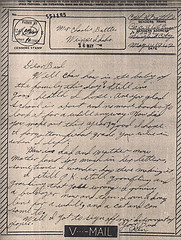Ever since modern postal systems developed in the mid-19th Century, mail has been one of the most common ways of supporting troops stationed far away. A letter from home is one of the few things a soldier in the field can look forward to. Today, e-mail has eclipsed traditional letters in popularity, but this is not the first technological change in the way our troops have kept in touch with home.
![]() photo credit: Homini:)
photo credit: Homini:)
V-mail was developed during WWII as a way to literally lighten the load of mail going back and forth by replacing thousands of letters with reels of microfilm. Correspondence was written on special forms, which were designed to be folded up and sealed to become an integral envelope. These forms were then photographed on microfilm, with several letters fitting on a single reel. This reduced the bulk of the mail 37 times and cut the weight by even more, allowing cargo planes to transport more war materiel.
Once the reels made it to their destination, they would be processed and the individual letters reproduced at about 60 percent of their original size. Then the letters would enter the mailstream for delivery to their addressees.
The process offered security advantages. Secret messages written in invisible ink would not be picked up by the photograph, and thus would not make it to a recipient. And since the original letter would be destroyed after photographing, secret messages could not be sent on microdots attached to the letters either.
![]() photo credit: Homini:)
photo credit: Homini:)
Not everything was perfect with V-mail. Some complained about the forms being too short for meaningful correspondence. Small writing was discouraged, because the letters would not be reproduced at their full size on the other end, and certain colors of ink did not show as well on the photographs as others. But it was a creative solution to some of the logistics problems with delivering mail during wartime, and to the people who used it, it sure was better than no mail at all.

